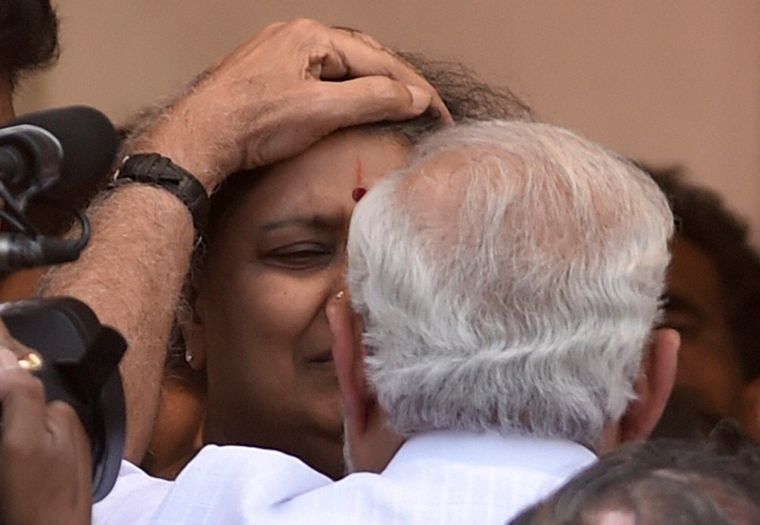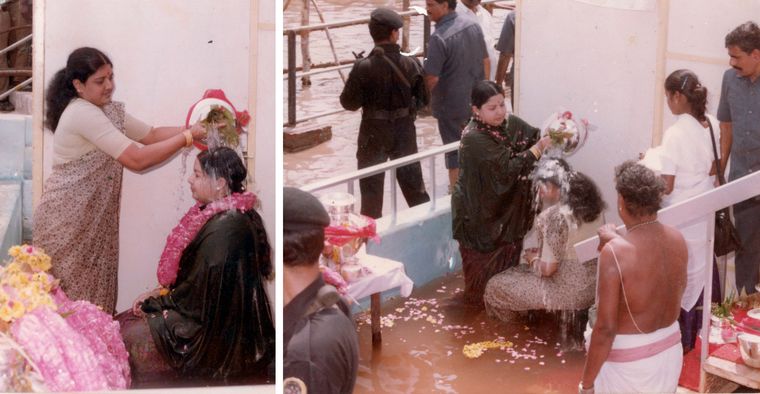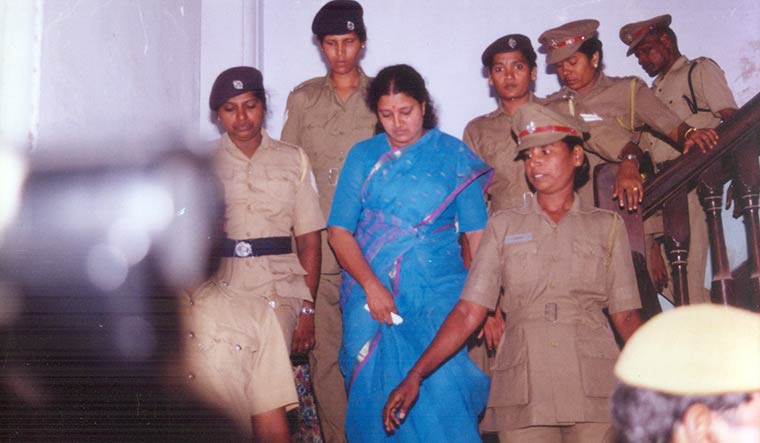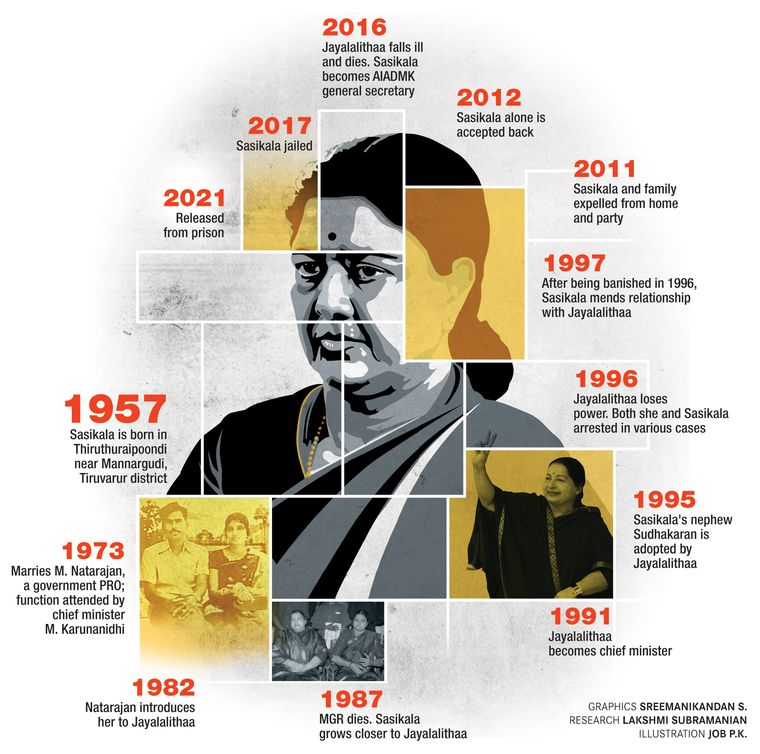Tamil Nadu is under total lockdown. The towering steel gate of a swanky bungalow on Habibullah Road in Chennai’s T. Nagar is closed. A security guard checks my name against a list and lets me in. An assistant calls the lady of the house on the intercom and informs her about my arrival. On cue, the wooden door opens, and I am ushered in. Portraits of former chief ministers M.G. Ramachandran and J. Jayalalithaa adorn the walls of the small visitors’ room. I take a seat on the long, brown sofa, and in no time, a steaming mug of strong filter coffee is served.
As I set the empty mug down on the glass coffee table, in comes V.K. Sasikala, clad in an all-grey salwar suit. “Vanakkam (greetings),” she says, her hands folded. Even though the mask covers her smile, I can see it in her eyes. Sasikala was Jayalalithaa’s confidante, staying by her side in politics and life. Their friendship weathered many a storm. Everyone thought that she would fade into oblivion post the developments following Jayalalithaa’s death on December 5, 2016, including her 2017 conviction in a disproportionate assets case.
On her release from the Bengaluru prison this January, she had announced a step back from politics. But now, Sasikala, who has been well-versed with the internal politics of the All India Anna Dravida Munnetra Kazhagam (AIADMK) for more than 33 years, is set to make a comeback—all to keep her friend’s legacy alive. And, it is to document this friendship between the two—once the most powerful women in Tamil Nadu politics—that I have been waiting to meet Sasikala for years.
“All well with you?” she asks me. As I inquire about her health, she says, “I got the letters you wrote to me when I was in prison. Sorry, I could not reply and also could not give you time to visit me, as there were several restrictions on people visiting me in the prison.” The four years in prison were the most difficult phase of her life, she says. The last year was particularly lonelier, with fewer visits owing to pandemic-induced restrictions. Her appeal for remission was rejected. And, just before her release from jail was approved, she caught Covid-19 and was shifted to a hospital.
Neither Sasikala nor her family want to dwell too much on her time in jail and hospital. All she divulges is that while in hospital, her only thought was to get well soon and return to Tamil Nadu. “I swore at akka’s (elder sister’s) memorial that I would come back, defeat all the betrayers and save the party. And now I am on it,” she says.
A bond begins
Sasikala was born in 1954 to a farmer couple—Vivekanandam and Krishnaveni—at Mannargudi near Thanjavur. Despite hailing from the influential Kallar community (commonly known as Thevars) and being land-holders, the family was not rich. With her father’s Dravidian-Periyar leanings, their humble abode would be abuzz with political news, thanks to All India Radio. A discussion would always follow the news.
Later, Sasikala’s wedding with M. Natarajan in 1973 was solemnised by chief minister M. Karunanidhi of the Dravida Munnetra Kazhagam. No Hindu rituals were performed at the wedding. Despite their political connections, the couple struggled to make ends meet. They moved to Chennai where Natarajan worked as a public relations officer in the state’s directorate of information and public relations department.
The Emergency days were difficult as cases were filed against Natarajan for his involvement in the anti-Hindi agitation. He was unemployed from 1976 to 1980. To support the family, Sasikala started a video rental shop. But the money from the shop was not enough, and Sasikala had to pawn and sell her jewellery to fight the cases against her husband.
Soon after M.G. Ramachandran, aka MGR, came to power, Natarajan started working as PRO at the district collector’s office in Cuddalore, then South Arcot, in the early 1980s. That is when Jayalalithaa, who was the propaganda secretary of the AIADMK, went on a state-wide tour to popularise the midday meal scheme. MGR asked South Arcot district collector V. Chandralekha to ensure the best media coverage for Jayalalithaa’s tour. Chandralekha delegated the responsibility to Natarajan, who roped in his wife to cover Jayalalithaa’s programmes. That was the beginning of a lifelong friendship. By the late 1980s, Sasikala and Natarajan had moved into Jayalalithaa’s Veda Nilayam at Poes Garden. Their bond further strengthened after MGR’s death.
With grief, comes growth
MGR died in the wee hours of December 24, 1987. As soon as Jayalalithaa heard of his death, she rushed to his Ramavaram Gardens residence with Sasikala. “The gate was closed. We drove on, breaking it open,” recalls Sasikala. “Akka cried. But MGR’s family members tried to lock her inside a room on the ground floor. We didn’t leave. We saw the body being brought down from the first floor. As it was put on a stretcher and taken in an ambulance, we rushed out, got in our car and followed the ambulance. [T.T.V.] Dhinakaran [Sasikala’s nephew] drove the car.”
Worse, Jayalalithaa was pushed down from the hearse carrying MGR’s body. “Akka was injured. We came back home,” says Sasikala. When they reached Poes Garden, Jayalalithaa fell in front of the portrait of her mother Sandhya and cried saying, “I lost, amma.” Sasikala saw how upset and disturbed she was. “That is when I decided that I should be with her,” she says.
Though she was MGR’s protégé, Jayalalithaa had to fight her way to the top of the party. Every attempt was made to side-line her after MGR’s death. The AIADMK split into two factions—one led by Jayalalithaa and the other by MGR’s wife Janaki.
As Jayalalithaa staked her claim on the party, Sasikala stood by her side. “She went on a tour, and I accompanied her throughout,” she says. When Jayalalithaa was looking for a party office, Sasikala, through Natarajan, found a place in Alwarpet in one night. “I got a huge steel rod from Parry’s Corner and got it painted red and white to make the flag post for our new party,” she recalls.
Also read
- 'Time is ripe, my entry has begun': Sasikala vows to usher in Amma's rule in TN
- Former CM's aide Sasikala chooses Jayalalithaa's birthday to return to Poes Garden
- Sasikala visits Kodanad estate amid CB-CID probe into heist-cum-murder case
- Police to question Sasikala in Kodanad heist and murder case
- OPS's brother expelled from AIADMK a day after he met Sasikala
Later, Sasikala along with her husband went to Ramavaram to convince Janaki to give up her claim on the party. “Akka told me not to go. She said nothing will come of it,” says Sasikala. “But I was stubborn and said that I will go and talk with Janaki amma and unite the party. Akka told me, ‘Do as you wish’, and walked up the stairs.”
Sasikala says they met up with Janaki in the evening. The latter told them that she had decided to give up. “She sent out the news to Doordarshan then through [TV host] A.V. Ramanan,” says Sasikala. “We came home. Soon, akka took over as the leader of the AIADMK.”
With so much love for Jayalalithaa and the AIADMK, one wonders why Sasikala stepped aside from the party during the last assembly elections. “How can I campaign against the two leaves symbol?” she asks.
Seeking simple pleasures
During her 33-year stay at Poes Garden, Sasikala had never stepped out without Jayalalithaa’s knowledge. “If I was missing at home, she would immediately call me and ask about my whereabouts,” she says. The only place she used to visit without Jayalalithaa was the Milan Jyothi showroom in Chennai to purchase the former chief minister’s favourite Garden Vareli saris. “She loves green, that too dark green. She felt it was her lucky colour,” says Sasikala.
Sasikala would buy the sari material in rolls. Two Muslim tailors would then embroider the sari border. “It would be done as a small patch. I would buy the matching colour thread for the embroidery,” says Sasikala. She would get a sample patch done, get it approved by Jayalalithaa and pass it on to the tailors. “She was never for expensive jewellery. She always preferred to be simple,” says Sasikala.
Every time though, Sasikala would pick a pair of identical saris. “Whenever she wore a new sari, she would insist that I also wear the same colour and design,” says Sasikala. She recounts how during an income tax raid in 2018 at Poes Garden while she was in jail, a lady officer was flummoxed to see two rows of saris in the same design and colour in the wardrobe.
For Sasikala, materials, like the green sari, have become tangible cues to memories past. She says she has stopped eating fried groundnuts, green peas and neer kozhukattai (steamed rice balls)—all Jayalalithaa’s favourite snacks. “I used to remove the skin of groundnuts and give them to akka whenever we were on tour. When I see groundnuts, I remember the days we spent together.” Recently, when a relative brought her steamed rice balls, she asked that the snack be taken back as it reminded her of Jayalalithaa.
Jayalalithaa also needed her filter coffee fix on tour. She liked it strong, served in the traditional tumbler set. “I would carry a kettle and coffee powder for decoction only to prepare coffee for akka wherever she went,” says Sasikala.
Though Jayalalithaa had a sweet spot for cakes baked in five-star hotels, she preferred home-cooked food over fancy cuisine. “She loved anni’s samayal [cooking],” says Sasikala. Anni is Sasikala’s co-sister Elavarasi Jayaraman, who was also jailed in the disproportionate assets case. Jayaraman’s kovakkai poriyal (sautéed ivy gourd, seasoned with a little ‘gun powder’ and pepper) and tomato rasam were Jayalalithaa’s favourite.
Jayalalithaa loved pets, particularly dogs. She had 13 dogs. “Julie was her favourite,” says Sasikala. Julie was Sasikala’s pet before she came to Poes Garden. The moment Jayalalithaa walked in, recalls Sasikala, Julie would start wagging her tail and would wait till her mistress finished her conversation with the visitors. Julie would follow her upstairs to her room, wait at the doorstep till she freshened up and then get on to her lap. The day Julie died, Jayalalithaa had left for Hyderabad and was supposed to go to Delhi to meet BJP leader L.K. Advani. But when she heard of Julie’s death, she cancelled the meeting and rushed home. “She did all the rituals and we got Julie buried in the lawn at Poes Garden,” says Sasikala. “Akka loved dogs. She would feed them, and sometimes take them for morning walks.”
Jayalalithaa yearned to take long walks on the beach, but it was a luxury that she could ill afford because of her position. “There were days when we would go near Mahabalipuram and go for long walks late at night,” says Sasikala. Jayalalithaa loved Mahabalipuram and its architecture. But her favourite retreat was her Kodanad tea estate. Sasikala becomes teary-eyed when she speaks about Kodanad estate. In Kodanad, she says Jayalalithaa preferred to go for boat rides or walks. She talks about the robbery and murder of the Kodanad security guard in April 2017, saying the mystery behind it is still not resolved. The two accused met with separate accidents; only one of them survived. “It is actually a conspiracy,” she says, adding that the then AIADMK government could have resolved it.
Rift in relations
Sasikala’s and Jayalalithaa’s friendship did hit a rough patch. Sasikala was twice expelled from the party. Between June 1996 and April 1997, Sasikala was in jail in a Foreign Exchange Regulation Act case, which is still pending in a magistrate’s court. Jayalalithaa, too, was arrested, but was released on bail 45 days later. In a press conference, she blamed Sasikala’s family and vowed to banish them from Poes Garden.
“Akka has never been without me for even a minute. It [the expulsion] was only for the outside world, but we were talking with each other,” reveals Sasikala. “When I [fell sick in jail] and was taken to the government hospital, the news shook her and she rushed to the hospital. She was on her toes, impatiently inquiring with the doctors about my condition.”
Sasikala was banished from Poes Garden again in December 2011. Exactly after 100 days, in March 2012, she returned to the residence after issuing a public apology to Jayalalithaa.
She wrote that her family members would not call the shots in the party and no one from the Mannargudi clan would be allowed inside Poes Garden. She also promised to stay away from everyone in the family.
Sasikala says that this expulsion was again for people’s sake. It was on Jayalalithaa’s instruction that she stayed at the T. Nagar house. “It was all planned,” says Sasikala. “She would call me over the phone every day. The phone conversation with akka would begin by 8pm and end only at midnight. She would discuss every political development with me.” Apparently, the public apology was also Jayalalithaa’s suggestion.
“It [the 2011 expulsion] was only to know the roles played by people like Cho [Ramaswamy, political commentator] and a police officer who was heading the intelligence then [in influencing government officials against Jayalalithaa and Sasikala],” says Sasikala.
After her return to Poes Garden, Sasikala says that Jayalalithaa regularly spent time with her after a tiring day. “She would lie down on my lap like a little girl,” she says. Jayalalitha, in an interview with TV host Simi Garewal, said that Sasikala “is like my mother”. And, twice in the Assembly, she referred to Sasikala as her “udanpirava sagothari”—a sister not related by blood.
A friend in Modi
The sisterhood gave Sasikala a ringside view of politics, state and national. She recalls how Modi broke protocol to have lunch with Jayalalithaa at Poes Garden on August 7, 2015. The prime minister and Jayalalithaa, she says, were closeted before partaking a simple vegetarian meal, home-cooked especially for Modi. “Akka was very particular that the prime minister was served the best of south Indian dishes,” she says. “He loved appam. I remember the prime minister asking for it again and again. Akka was so pleased that he liked south Indian cuisine.” Those were the days when the AIADMK was the third largest party in Lok Sabha, and had 11 members in Rajya Sabha. Over lunch, the two leaders discussed the Goods and Services Tax bill. “Akka was never for the GST bill,” recalls Sasikala.
Modi apart, Poes Garden had hosted several national leaders, like L.K. Advani and Rajiv Gandhi. “Advani had huge respect for akka,” says Sasikala. “But Modi was always her friend.” She recalls how Modi rushed to Chennai to pay his last respects to Jayalalithaa. “He knew I was completely shattered when akka died,” she says.
Among BJP leaders, Sasikala’s favourite is former prime minister A.B. Vajpayee. “I used to listen to his speeches in the early 1980s on radio. My father was a staunch follower of Vajpayee’s speeches those days,” she says. But she met Vajpayee for the first time when the AIADMK extended support to the BJP government in 1998. But it lasted only 13 months as Jayalalithaa pulled out of the coalition. “It was akka’s decision to withdraw support,” says Sasikala. “I advised her not to. We fought over it for several hours. But she was stubborn.”
Sasikala says that Jayalalithaa announced her plans to withdraw support when they left Chennai for Delhi. “I got into the [Chennai] airport through a different gate, while she came in through another one where the media asked for her comments,” she says. “She was categorical that she withdrew the support. I did not know this. We reached Delhi. And as I switched on the TV, [I saw] akka’s comments. I was shattered. I pleaded with her. I argued, even fought. But she did not relent. The government fell.”
Another issue where the two friends disagreed with each other was when Kanchi seer Jayendra Saraswathi was arrested at Chennai airport in a murder case in 2003. “I fought with akka the whole night,” she recalls. “I said it would only ruin the party’s image. But for her, every wrongdoer must be punished. I even fell at her feet, but she did not take my advice then.” The seer’s arrest turned the Brahmin community in Tamil Nadu against the AIADMK.
Bound by faith
Jayalalithaa was highly spiritual. She would never skip prayers no matter how busy her schedule. Every morning, 45 minutes were dedicated to chanting hymns like Hanuman Chalisa and Soundarya Lahari. “Akka got this habit from her grandmother, who was very spiritual and orthodox,” says Sasikala. On her return from work, Jayalalithaa would be given a small pot of water. “She would spill a few drops on her feet and a few on her head and only then get into the main hall,” says Sasikala.
On official tours, Sasikala would carry two boxes with miniature idols of Jayalalithaa’s favourite deities—Lord Perumal, Lord Venkatachalapathy and Lord Murugan. The boxes also had all the puja essentials. “I would arrange fragrant flowers for her puja every day,” says Sasikala. “Though she was an ardent devotee of Lord Vishnu (Perumal in Tamil), she offered prayers to every other deity, too. She would chant Ramaneeyam and Baagavatham very often. I got all the lyrics stored on the iPad when she was in the hospital. I would read it out for her.” Sasikala says she even memorised all the hymns for Jayalalithaa’s sake.
Adieu, Akka
Sasikala’s eyes still well up when she talks about Jayalalithaa’s final days. As tears roll down her cheeks, she wipes them with a tissue and takes a deep breath before recalling the events of the evening of September 22, 2016. “Everything was fine,” she says. “Akka and I were chatting in the bedroom. Akka went to the washroom and came out. She said she felt giddy. As I walked towards her, she fell onto me. Holding her up with one arm, I reached for the phone and called the doctor and security officers. I was devastated.” Sasikala shows the small wireless intercom phone she used to alert the security. When she stayed with Jayalalithaa in Poes Garden, she always carried the phone in her salwar suit’s pocket, so that Jayalalithaa could always reach her.
When Jayalalithaa was taken to the hospital, Sasikala hoped she would be back home soon. “She was fine. The next day she instructed authorities on the Cauvery water issue. But at last, none of our prayers saved her,” she says, wiping her tears. Jayalalithaa was in the hospital for 75 days. “Akka was fine till the evening of December 4 [the eve of her death],” says Sasikala. “I had decided to take her back home on December 19, after she had completely recovered. Akka wanted to go to Kodanad and take rest there. But I advised her that we stay back at Poes Garden and then go to Kodanad. She agreed. I never thought akka would leave me.”
On December 4, Jayalalithaa had only curd rice. Doctors advised her to eat at regular intervals. So, Sasikala, accompanied by the hospital dietician and the Poes Garden cook, went to the hospital kitchen to get two dinner buns and a cup of filter coffee for her. “Those are small dinner buns. Akka likes it only if the top layer is a little extra brown,” says Sasikala. “So, I went to get it prepared myself.” She placed the bun and coffee on a trolley and rolled it next to Jayalalithaa, who was lying on the bed watching Jai Hanuman. “She had placed the TV remote on her thigh and I went to take it,” recalls Sasikala. “Before I could give her the coffee, she fell back with a huge gasp. The doctor was standing near the bed, writing the daily medication. As I yelled, he came running. I shouted, ‘akka, akka’. [Every time I called her name], she would struggle to open her eyes and sit up. But, despite my cries, she fell back and was moved to the ICU.”
On the fifth of every month, Sasikala holds prayers for Jayalalithaa at home. Her offering: two dinner buns and a cup of strong filter coffee.
CASES AGAINST SASIKALA
THE INTIMIDATION CASE
Booked on June 30, along with 500 unidentified supporters, for allegedly intimidating former law minister and AIADMK Villupuram district secretary C.V. Shanmugam. This case is not expected to trouble Sasikala too much, politically. However, her FERA and income tax cases are likely to be more troublesome.
THE FERA CASE
The case under the Foreign Exchange Regulation Act, 1973, was filed in 1996. Charged with remitting foreign currency worth Rs3.29 crore from Malaysia. A Rs3 crore-loan was obtained against this deposit. The money is said to have been used to purchase shares of the Kodanad estate, one of Jayalalithaa’s favourite destinations.
INCOME TAX CASES
In October 2020, the IT department attached properties worth more than Rs2,000 crore under the Benami Property Transactions Act, 1988. These included the palatial white mansion at the Kodanad estate and the Siruthavur resort in the outskirts of Chennai. The IT department also attached assets worth Rs1,500 crore, allegedly purchased using demonetised currency.










